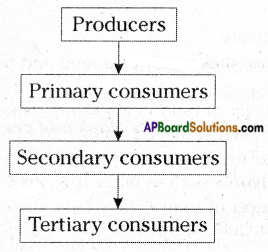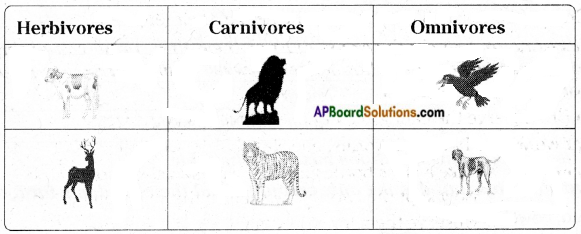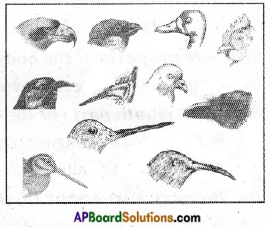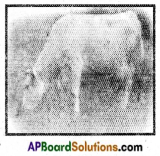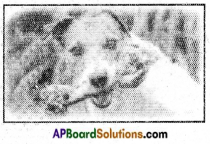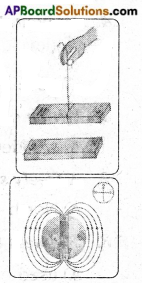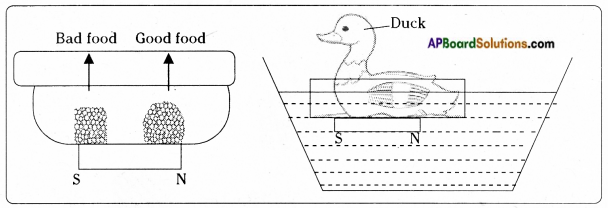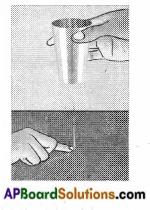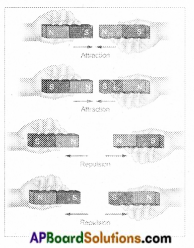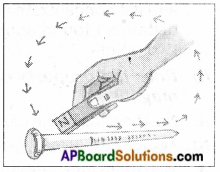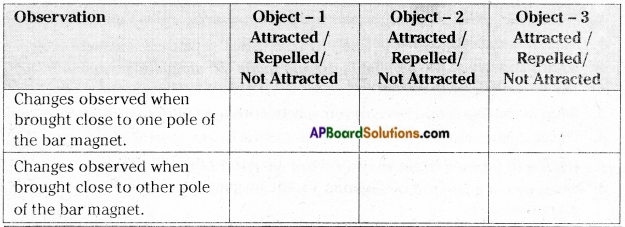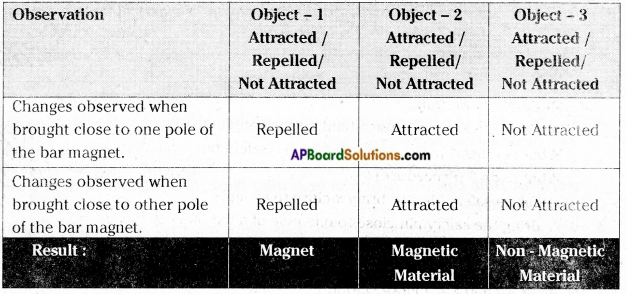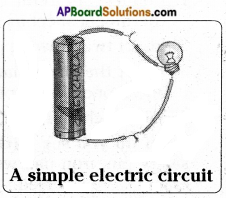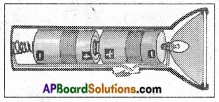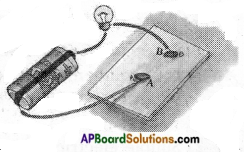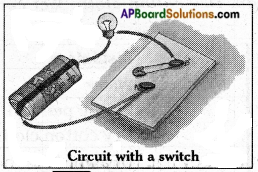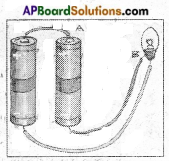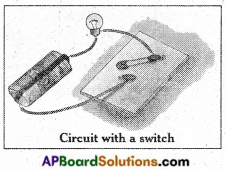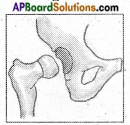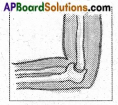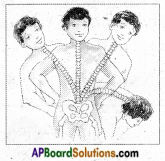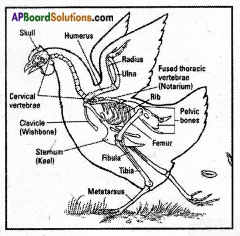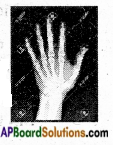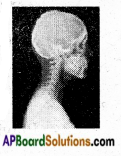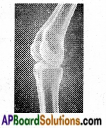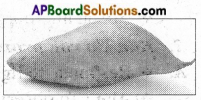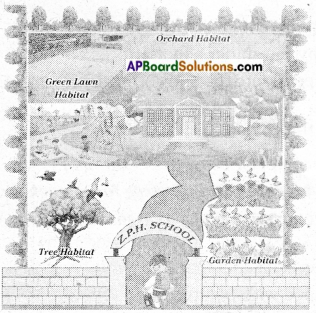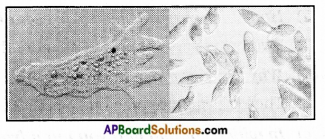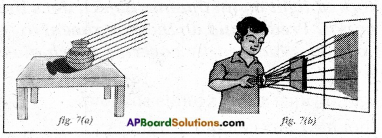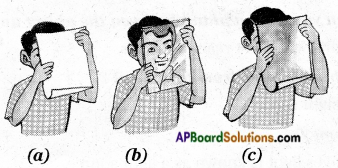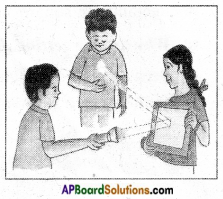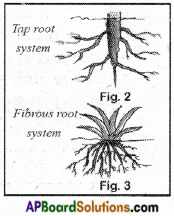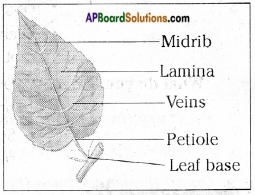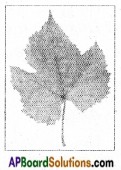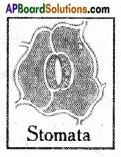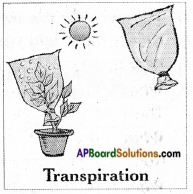AP State Syllabus AP Board 6th Class Science Important Questions Chapter 4 Water
AP State Syllabus 6th Class Science Important Questions 4th Lesson Water
6th Class Science 4th Lesson Water 2 Mark Important Questions and Answers
Question 1.
Where do we get water from?
Answer:
We get water from rivers, ponds, lakes, canals and borewells.
Question 2.
For what purpose do we need water?
Answer:
We need water to perform day to day activities like cooking food, washing clothes, cleaning utensils, bathing etc.
Question 3.
Name the two processes responsible for the formation of clouds.
Answer:
Two processes are responsible for the formation of clouds.
- Evaporation
- Condensation
![]()
Question 4.
Write any natural disasters that are related to water.
Answer:
- Floods
- Tsunami
- Drought
Question 5.
Give some examples of fruits and vegetables that contain more water.
Answer:
Vegetables: Cucumber, tomato, bottle gourd, snake gourd, etc.
Fruits: Watermelon, lemon, orange, muskmelon, mango, etc.
Question 6.
What are the main water sources in villages?
Answer:
In villages wells, canals, tanks, ponds, rivers, etc. are the main water sources.
Question 7.
What are juicy fruits ? Give examples.
A. The fruits that contains more water are called juicy fruits. Ex : Watermelon, grapes, orange, muskmelon. .
Question 8.
What are the forms of water?
Answer:
There are three forms of water in nature. They are
Ice (Solid form), Water (Liquid form) arid Water vapour (Gaseous form)
Question 9.
What is evaporation?
Answer:
The process of water changing into water vapour is called evaporation.
Question 10.
What is a cloud?
Answer:
The water vapour which enters into air through the process of evaporation forms clouds in the sky. .
Question 11.
Define condensation.
Answer:
The process of conversion of water vapour into water is called condensation.
Question 12.
When does a drought occur?
Answer:
If there is no rain for a long period, it may cause drought.
Question 13.
What are hailstones?
Answer:
Big drops of water solidify into ice and fall as pieces of ice known as hailstones.
Question 14.
What do you understand by the word ‘Precipitation’?
Answer:
The kind of weather condition where rain, snow, sleet or hail fall from the sky is called precipitation.
![]()
Question 15.
Define the Hydrological cycle.
Answer:
The circulation of water between the earth surface and air is called the Hydrological cycle or water cycle.
Question 16.
What are the main reasons that disturb the water cycle?
Answer:
Deforestation and pollution are the main reasons that disturb the water cycle.
Question 17.
What happens if there is less rainfall or too much rainfall?
Answer:
If there is less rainfall its results in droughts or water scarcity and too much rainfall results in floods.
Question 18.
Name the drought-prone districts in Andhra Pradesh.
Answer:
Ananthapur, Kadapa and Kurnool are drought-prone districts in AP.
Question 19.
Fill the blanks with suitable answers.
A → Water → B
Answer:
A. Ice,
B. water vapour
Question 20.
What is the specific measurement of volume for liquids?
Answer:
Water and other liquids are measured in litres.
![]()
6th Class Science 4th Lesson Water 4 Mark Important Questions and Answers
Question 1.
What is evaporation? What its importance in our life?
Answer:
- Evaporation is the process of water changing into water by applying heat.
- Evaporation of water helps the atmosphere to provide moisture.
- It helps in the formation of clouds.
- It cools our body from the sweat.
Question 2.
Write the situations of evaporation that we see in our daily life?
Answer:
We observe evaporation by the following situations in our daily life.
- Wet clothes drying under the sun.
- Hot tea getting cold.
- Drying of mopped floor.
- Drying of lakes and rivers
- In the preparation of salt from the sea.
- Grains and fishes dry under the sun.
- In the formation of clouds.
Question 3.
What is the importance of water in our daily life?
Answer:
- Our body needs water to maintain temperature and bodily functions.
- Water helps in digestion of food.
- Water helps to removal of toxins from the body.
- It improves skin moisture.
Question 4.
How do you appreciate the people who dicing a well?
Answer:
- Tapping of ground water by digging a well is tough job.
- The place where the well is to be dug is selected first.
- Workers using cow bars and spades begin to remove the soil at that place.
- The process of digging continues till water in the underground found.
![]()
Question 5.
How can you say that three forms of water are interchangeable?
Answer:
- Water is available naturally in three forms as ice, water and water vapour.
- When ice is heated it converts into water and if water is heated it turns into water vapour,
- Where water vapour is cooled it converts into water. If water cooled further, we will get ice.
- So, we can say that three forms of water are interchangeable.

Question 6.
Explain how the evaporation takes place.
Answer:
- If water is gently heated, it will become warm and vapour is produced.
- If we heat more it .starts boiling and converts completely into water vapour.
- The amount of heat absorbed by water affects its evaporation.
- If water is heated more, it will evaporate more.
Question 7.
What is the relation between rains arid clouds?
Answer:
- Clouds are formed by evaporation of water.
- When water vapour rises in the sky it forms clouds.
- The clouds are coolecl by cool breeze.
- Then the water present in the clouds condense and they become heavy and descend towards the earth as rain.
Question 8.
Why don’t all clouds cause rain?
Answer:
- The clouds moving in the air are generally at higher levels.
- The cool breeze along with the air makes the clouds cooler.
- Due to this water vapour condenses and causes rain.
- When the warmer air touches the clouds, it makes the water evaporate easily. So that that clouds cannot cause rain.
Question 9.
You might have observed a small dew-drops appeared on grass and leaves of plants. From where do these water-drops came on the leaves and grass?
Answer:
- During the winter season due to low temperature, the fog in the air settle on the grass and plants.
- Due to the transpiration process water is also evaporate through stomata. It also condensed to form fog.
- This fog condensed into tiny droplets of water which is called as dew.
- We can observe this dew only in the early hours of the day.
![]()
Question 10.
Have you observed in your daily life where water vapour changes into water? List out them.
Answer:
Yes. Here are the following situations where water vapour changes into water.
- Dew forming on grass and plants in early morning.
- Eye glasses fogging up in a cold winter day.
- Water drops forming a glass holding a cool drink or ice cream.
- Cooked food lid get water drops when the vessel cooled.
Question 11.
What changes do you notice in the sky and in the atmosphere before it rains?
Answer:
- Before the rain the sky becomes dark due to the condensation of the water or the formation of clouds.
- The atmosphere becomes very humid so that we feel so suffocated.
- The sky is covered with rainy clouds and cool wind.
- Some times thundering and sparkling may be occurring.
Question 12.
What are the types of monsoons?
Answer:
There are two types of monsoons in India.
1. South-West monsoon 2. North-East mortsoon
- South-West monsoon: During the months of June to September clouds are moving along with the winds blowing from western direction. These winds are called SouthWest Monsoon.
- North-East monsoon: In the months of November and December rains occur due to the movement of clouds in the direction of winds blowing from Eastern side. These winds are called North-East monsoon
Question 13.
How the rain water restores in water sources?
Answer:
- Water that comes from rainfall runs down as small streams.
- These small streams join together and make bigger streams.
- These bigger streams join the rivers.
- The rivers flow down to seas and oceans.
- Some of the rain water seeps into the ground and becomes ground water.
Question 14.
Prepare slogans on Water Conservation.
Answer:
- Water is gift from the creator. Protect it!
- Do the earth a favour- Be a saver.
- Save the water and save the life on the earth.
- Water is essence of life, save rain water.
Question 15.
What precautions do you follow to prevent the water scarcity?
Answer:
- Educate the people to change consumption of water and their life styles.
- Recycle the waste water.
- By following the water management techniques.
- Improve irrigation and agricultural practises
- By following water conservation methods such as rain water harvesting etc.
![]()
Question 16.
Which departments serve in natural disaster condition?
Answer:
- National Disaster Relief Force, State Disaster Relief Force, local fire, Health, Police and Revenue department helps the victims of natural disaster.
- Military also participate in relief activities of natural disaster.
Question 17.
What are the reasons for water scarcity?
Answer:
The main reasons for water scarcity are
- Population explosion
- Uneven distribution of rainfall
- Decline of ground water table
- Pollution of water
- Careless use of water
6th Class Science 4th Lesson Water 8 Mark Important Questions and Answers
Question 1.
Why the rainy season important for us?
Answer:
- In India, the rainy season is known as Monsoon.
- The season lasts in India for about 3-4 months.
- Indian population mainly depends on agriculture.
- So, the harvesting is largely depending on the quality of rain.
- The rainy season also significant to maintain groundwater levels.
- All the living and non-living things directly of indirectly depend upon the rainy season.
- The monsoon provides us to collect the runoff water by different methods of rainwater harvesting.
- The rains help to replenish the freshwater which is essential for life on the planet.
Question 2.
What are the main types of precipitation? Explain.
Answer:
There are four main types of precipitation. They are rain, sleet, snow and hail.
- Rain: Water droplets fall when the air temperature is above freezing.
- Sleet: This occurs when raindrops fall through freezing air, then they turn into pellets of ice.
- Snow: When the water vapour passes through the very cold air, the water vapour crystallizes and forms snowflakes.
- Hail: These forms when thunderstorm winds push water back up into the atmosphere. The water turns into ice coated with more water and pushed up to freeze again.
![]()
Question 3.
Classify the uses of water in three groups. Uses in a house or a family, for agriculture purposes and others.
Answer:
- Uses of water in a house: For drinking, bathing, washing, cleaning of vessels, toilets etc.
- For agriculture: Water is essential for germination of seeds, irrigation of crops,
- Others: Water helps to maintain our body temperature constant.
Water is used to generate electricity.
Water is used in many industries.
Question 4.
Write briefly about the water sources.
Answer:
Water is mainly available in three forms. 1. Ice 2. Water 3. Water vapour
1. Ice:
- It is a solid form of water. Snow occurs naturally.
- It is present in snow-covered mountains, glaciers and polar regions.
- 10% of the land area is covered with glaciers.
2. Water:
- It is a liquid form of water.
- 3/4 th of the earth surface is covered with water.
- It was present in oceans, seas, lakes, rivers and even underground.
- Seawater is salty. But water used by us in our daily purpose is not salty. It is known as freshwater.
- 3% of freshwater is available on earth.
3. Water vapour: The gaseous form of water. It was present in the atmosphere is 0.01%.
Question 5.
How the floods affect human life?
Answer:
Too much rainfall causes floods.
The immediate impacts of flooding include the following:
- Loss of human life,
- Damage to property,
- Destruction of crops,
- Loss of livestock,
- Deterioration of health conditions due to water-borne diseases,
- Destruction of power plants, roads and bridges,
- People forced to leave their own homes,
- Disruption of supply of clean water, transport, electricity, communicating etc.
Question 6.
What are the causes of the droughts? How it affects human life?
Answer:
- When a rainfall is less than normal for a long period of years for a particular region results in drought.
- Deforestation and pollution from factories lead to global warming.
- Global warming changes the atmospheric conditions which are not favourable for clouds to get cooled.
- Consequently, it leads to a decrease the rainfall.
It effects of Human life:
- It is very difficult to get food and fodder.
- Drinking water is scarce.
- People need to travel long distances to collect water.
- The soil becomes dry, agriculture and cultivation become difficult.
- Many people who depend on farming for their livelihood, migrate to other places in search of jobs.
- There is a higher incidence of heatstroke.
- Economic loss and reduced income.
![]()
Question 7.
What are the methods of water conservation? Write about water management in briefly.
Answer:
There are mainly two methods followed by us to conserve the water.
1. Water management 2. Rainwater harvesting
1. Water management: Water management consists of the following factors.
a) Bringing awareness about the bad effects of throwing wastes into the water bodies
b) Recycling of water by separating pollutants.
c) Minimizing the use of chemical fertilizers in agriculture. It reduces the pollution of underground water.
d) Controlling deforestation.
e) Adopting drip irrigation and sprinkler irrigation in agriculture. In this way, a lesser amount of water can be used for irrigation.
Question 8.
Write about the water conservation method of rainwater harvesting.
Answer:
Direct collection and use of rainwater is called rainwater harvesting There are two types of rainwater harvesting.
a) Collecting water from where it falls.
Ex: Collecting water from the rooftops of the houses or buildings (Roof water harvesting)
b) Collecting flowing rainwater.
Ex: Collecting rainwater by constructing ponds with bund.




